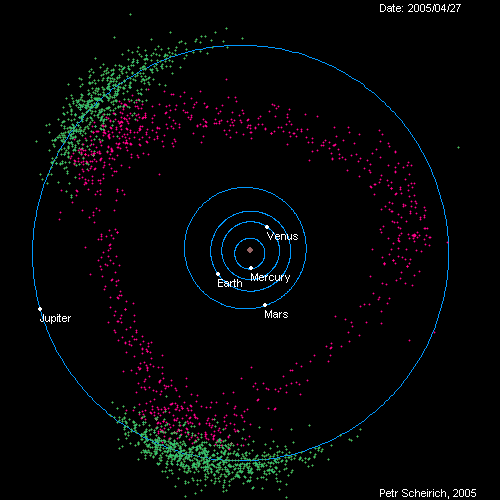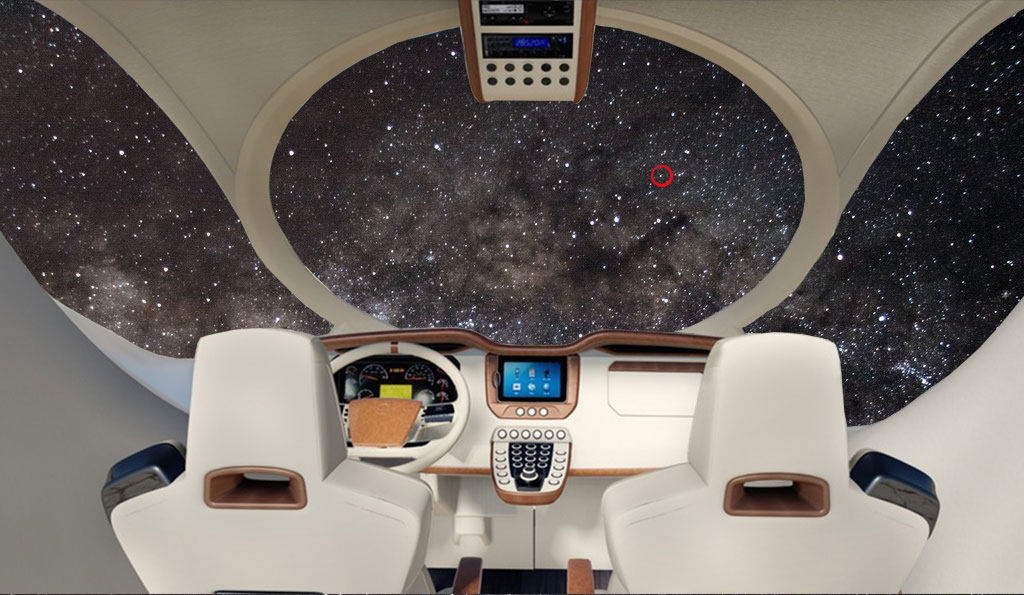Slingship Sam: Chapter 1
“Sam,” said the slingship, “I regret to inform you that asteroid 1303247 Hilco is far from its predicted position.”
Sam Flandern was bicycling on the beachside trail in Santa Barbara when the ship’s computer spoke. He didn’t stop pedaling. The Santa Ynez mountains towered on the north side of the bicycle path, and the Pacific Ocean lapped on the sandy beach on the south side. “Don’t give me that,” he said to the blue skies. “We aren’t due to pass Hilco for three more days.”

He slowed to maneuver the bicycle through a clump of tourists flowing off Stearns Wharf onto the bicycle path. He watched the pretty girls strutting in their summer bikinis.
Three days to asteroid 1303247 Hilco, where he would turn a sharp corner, then twelve days to double-asteroid 617 Patroclus/Menoetius, where he had a job waiting. Patroclus is the largest of the trailing Trojan asteroids in the L5 Lagrange point 60° behind Jupiter, 480 million miles from the Sun.
“Sam, asteroid Hilco A is far from its predicted position, much nearer to us than expected, on a significantly different vector. It has just now come into range of my detectors. Our closest approach will be in five hours. The iron companion Hilco B is not detectable at all. I believe you must modify your plan.”
Sam sighed and stopped pedaling and let go of the handgrips of the exercycle. The salt-spray scent of the sea and the virtual reality of the Santa Barbara beach scene faded away, and he was alone in the real-world stench of the rancid organics tank in his slingship 560 million miles from Earth.
“Okay, Fling, I’ll be right with you, let me stow this.” He folded the exercycle into its compartment in the living room of his Palazzo Superior motor home, the core living area of the slingship’s life support capsule, and went up front to the driver’s compartment and looked out the windshield.
He’d replaced the motor home windshield with quadrillion-pixel view plates. He hadn’t looked out at the stars for several days and it took him a moment to orient himself. He found the Milky Way, then he saw Jupiter and Saturn and had his bearings. He sat down in the right-hand seat.
“Okay, show me Hilco,” he said. He hadn’t had Hilco on his mind, Hilco was just a waypoint on his trip to Patroclus.
“Yes, Sam.” The starfield rotated a few degrees. A blinking red circle appeared around one of the points of light. The ship’s computer kept track of Sam’s head position and his eye motion and knew where Sam was looking and projected information onto the windshield for him.

“Okay, I see it,” Sam said. “Give me a closer look at it.” The point of light brightened and grew until it filled a quarter of the windshield. It was a battered chunk of pitted black rock shaped like a charred potato.
A potato. After nearly three months on slingship rations, Sam was seeing food everywhere.
A chart appeared on the windshield showing the astral specs for binary asteroid Hilco: a carbonaceous chondrite 11 miles long accompanied by a mile-wide nickel/iron satellite, Hilco B.
Sam was an orbital mugger: he was going to rob Hilco B of some of its orbital momentum. His corium-powered magnetic drive would transfer a small fraction of the asteroid’s speed to his slingship and make a final course corrections to aim directly into Patroclus Control’s big ground-based mag drive unit. The job at Patroclus was waiting, yes–for whoever got there first.
Hilco B was on Fling’s chart but it wasn’t on the screen. “Where’s the iron? It’s supposed to be a binary.”
“As I have already informed you, Sam, the iron companion cannot be detected.”
“We’ll have to recalculate the transaction,” Sam said. “How the heck did we get here three days too soon, anyway?”
“We won’t be able to make a satisfactory transaction of momentum,” the ship said.
“What? We won’t be close enough? How can that be?” One of the advantages of the mag drive is that it works over long distances. The further you are from your interacting mass, the more power it takes, of course, but since your corium drive can tap the orbital momentum of the mass for energy, you just take that much more. The only real constraints are the size and strength of your ship’s corium structure.
That’s for a magnetic interaction. The magneto-gravitic drive can also interact with an object’s gravitational field, but it takes a tremendous amount of energy, for small objects like a rock the size of Hilco. “How close are we going to get?”
“At our closest on our present orbit we will be within 5,000 miles of Hilco, in five hours,” Fling said. “But Sam, the binary companion is not in any detectable orbit.”
Sam blinked. “It’s gone?” The mag drive worked best on magnetic materials or magnetic fields. “The iron is gone?”
“It is not detectable with our radar equipment.”
“Then how am I going to turn the corner here? How am I going to get to Patroclus?”
“I do not have that information, Sam.”
“Why didn’t you tell me about this earlier. Five hours until periapsis?!”
Fling said, “My programming didn’t call for a sensor detection of the target rock until this moment.”
“How could we make such a big mistake, anyway?” he said. “Are you sure this is the right rock?”
“Spectrum of this carb matches that of Hilco A,” Fling said. “However its velocity vector is much different than listed in the ephemeris.” The ephemeris was the directory of orbital motions of all charted bodies in the solar system.
“We updated the ephemeris before we left Interamnia,” Sam said. That had been a project in itself–his bank account was frozen by NASA, but he’d traded 50 MREs under the table to get the update. “How much can a solar system change in three months?”
“I conjecture that Hilco has interacted with another asteroid, and lost the iron companion.”
“Okay, so we can’t swing to Patroclus off this rock. What’s the next rock we’ll encounter?”
“I warned you against this path, Sam. I told you how dangerous it was.”
“Yeah, skip the recriminations. I was the one who decided.” Usually in the Belt you have plenty of rocks to sling yourself along with. When the asteroids are thick you can move right along, slinging from one to the next to increase your speed. Sam had wanted an extra-fast transit for an extra-long trip–he wanted to get from asteroid 704 Interamnia to 617 Patroclus, in Jupiter’s orbit, in time to get the job.
“Okay, so what’s our back-up rock?”
“That’s what I was trying to tell you. We don’t have one.”
“Fling, there are two million charted asteroids in the Belt, and a hundred thousand in the Kuiper belt beyond Pluto. Surely we’ll approach one sooner or later.”
“Yes, we will approach Kuiper Belt object Ixion in 12,244 days.”
“In years,” Sam said.
“Thirty two years, eight months, twenty three days, assuming we use maximum available solar thrust. Which is pretty faint out there.”
“Thirty three years! The ship won’t last that long, let alone me!”